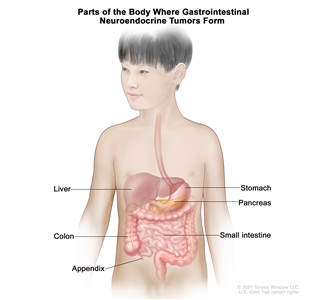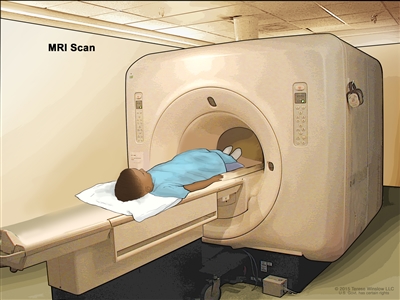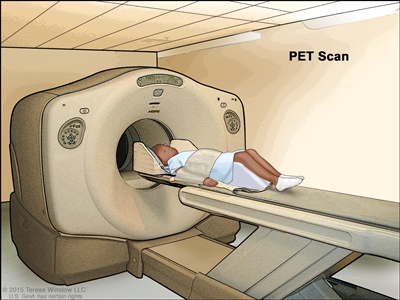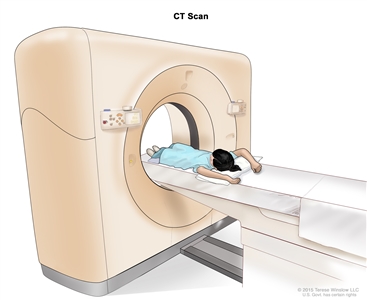Our Health Library information does not replace the advice of a doctor. Please be advised that this information is made available to assist our patients to learn more about their health. Our providers may not see and/or treat all topics found herein.
Childhood Gastrointestinal Neuroendocrine Tumors Treatment (PDQ®): Treatment - Patient Information [NCI]
This information is produced and provided by the National Cancer Institute (NCI). The information in this topic may have changed since it was written. For the most current information, contact the National Cancer Institute via the Internet web site at http://cancer.gov or call 1-800-4-CANCER.
General Information About Childhood Gastrointestinal Neuroendocrine Tumors
A gastrointestinal neuroendocrine tumor forms in neuroendocrine cells in the lining of the digestive tract, appendix, and other organs in the abdomen.
Gastrointestinal neuroendocrine tumors (also called gastrointestinal carcinoid tumors) form from a certain type of neuroendocrine cell (a type of cell that is like a nerve cell and a hormone -making cell). These cells are scattered throughout the chest and abdomen, but most are found in certain organs in the abdomen. Neuroendocrine cells in the digestive tract make hormones that help control digestive juices and the muscles used in moving food through the stomach and intestines.
Most gastrointestinal neuroendocrine tumors in children form in the appendix (a pouch that sticks out from the first part of the large intestine near the end of the small intestine). The tumor is often found during surgery to remove the appendix. They also form in the digestive tract (lining of the stomach or intestines), pancreas, and liver.
These tumors are usually small, slow-growing, and benign (not cancer). Some tumors may be malignant (cancer) and spread to other places in the body.

Gastrointestinal neuroendocrine tumors form in the lining of the gastrointestinal tract and other organs in the abdomen. Most gastrointestinal neuroendocrine tumors in children form in the appendix, but they can also form in the stomach, intestines, pancreas, and liver.
Signs and symptoms of gastrointestinal neuroendocrine tumors depend on where the tumor forms.
Check with your child's doctor if you are concerned about signs and symptoms that may be caused by gastrointestinal neuroendocrine tumors or by other conditions.
Neuroendocrine tumors in the appendix may cause the following signs and symptoms:
- Abdominal pain, especially on the lower right side of the abdomen.
- Fever.
- Nausea and vomiting.
- Diarrhea.
Gastrointestinal neuroendocrine tumors that are not in the appendix may release hormones and other substances. Carcinoid syndrome occurs when a neuroendocrine tumor in the digestive tract releases the hormone serotonin and other substances. It may cause any of the following signs and symptoms. Check with your child's doctor if your child has any of the following:
- Redness and a warm feeling in the face, neck, and upper chest.
- A fast heartbeat.
- Trouble breathing.
- Sudden drop in blood pressure (restlessness, confusion, weakness, dizziness, and pale, cool, and clammy skin).
- Diarrhea.
Tests that examine the digestive tract, liver, and pancreas are used to diagnose gastrointestinal neuroendocrine tumors.
The following tests and procedures may be used:
- Physical exam and health history: An exam of the body to check general signs of health, including checking for signs of disease, such as lumps or anything else that seems unusual. A history of the patient's health habits and past illnesses and treatments will also be taken.
- Blood chemistry studies: A procedure in which a blood sample is checked to measure the amounts of certain substances released into the blood by organs and tissues in the body. An unusual (higher or lower than normal) amount of a substance can be a sign of disease.
- MRI (magnetic resonance imaging): A procedure that uses a magnet and radio waves to make a series of detailed pictures of areas inside the body. The pictures are made by a computer. This procedure is also called nuclear magnetic resonance imaging (NMRI).

Magnetic resonance imaging (MRI) scan. The child lies on a table that slides into the MRI machine, which takes a series of detailed pictures of areas inside the body. The positioning of the child on the table depends on the part of the body being imaged. - PET scan (positron emission tomography scan): A procedure to find malignant tumor cells in the body. A small amount of radioactive glucose (sugar) is injected into a vein. The PET scanner rotates around the body and makes a picture of where glucose is being used in the body. Malignant tumor cells show up brighter in the picture because they are more active and take up more glucose than normal cells do.

Positron emission tomography (PET) scan. The child lies on a table that slides through the PET scanner. The head rest and white strap help the child lie still. A small amount of radioactive glucose (sugar) is injected into the child's vein, and a scanner makes a picture of where the glucose is being used in the body. Cancer cells show up brighter in the picture because they take up more glucose than normal cells do. - CT scan (CAT scan): A procedure that makes a series of detailed pictures of areas inside the body, taken from different angles. The pictures are made by a computer linked to an x-ray machine. This procedure is also called computed tomography, computerized tomography, or computerized axial tomography.

Computed tomography (CT) scan. The child lies on a table that slides through the CT scanner, which takes a series of detailed x-ray pictures of areas inside the body. - Ultrasound exam: A procedure in which high-energy sound waves (ultrasound) are bounced off internal tissues or organs and make echoes. The echoes form a picture of body tissues called a sonogram. The picture can be printed to be looked at later.

Abdominal ultrasound. An ultrasound transducer connected to a computer is pressed against the skin of the abdomen. The transducer bounces sound waves off internal organs and tissues to make echoes that form a sonogram (computer picture). - Twenty-four-hour urine test: A test in which urine is collected for 24 hours to measure the amounts of certain substances, such as hormones. An unusual (higher or lower than normal) amount of a substance can be a sign of disease in the organ or tissue that makes it. The urine sample is checked to see if it contains 5-HIAA (a breakdown product of the hormone serotonin which may be made by neuroendocrine tumors). This test is used to help diagnose carcinoid syndrome.
- Somatostatin receptor scintigraphy: A type of radionuclide scan that may be used to find tumors. A very small amount of radioactive octreotide (a hormone that attaches to tumors) is injected into a vein and travels through the blood. The radioactive octreotide attaches to the tumor and a special camera that detects radioactivity is used to show where the tumors are in the body. This procedure is also called octreotide scan and SRS.
Certain factors affect prognosis (chance of recovery).
Prognosis depends on the following:
- Where the tumor first formed in the body.
- The size of the tumor.
- Whether the tumor has spread to other parts of the body.
- Whether the tumor is newly diagnosed or has recurred (come back).
The prognosis for neuroendocrine tumors in the appendix in children is usually excellent after surgery to remove the tumor. Gastrointestinal neuroendocrine tumors that are not in the appendix are usually larger or have spread to other parts of the body at the time of diagnosis and do not respond well to chemotherapy. Larger tumors are more likely to recur (come back).
Stages of Gastrointestinal Neuroendocrine Tumors
After a gastrointestinal neuroendocrine tumor has been diagnosed, tests are done to find out if cancer cells have spread to nearby areas or to other parts of the body.
The process used to find out if cancer has spread to nearby areas or other parts of the body is called staging. There is no standard staging system for childhood gastrointestinal neuroendocrine tumors.
Neuroendocrine tumors of the appendix are not known to spread, but other gastrointestinal neuroendocrine tumors may spread. The results of tests and procedures done to diagnose gastrointestinal neuroendocrine tumors are used to help make decisions about treatment.
Sometimes childhood gastrointestinal neuroendocrine tumors recur (come back) after treatment.
There are three ways that cancer spreads in the body.
Cancer can spread through tissue, the lymph system, and the blood:
- Tissue. The cancer spreads from where it began by growing into nearby areas.
- Lymph system. The cancer spreads from where it began by getting into the lymph system. The cancer travels through the lymph vessels to other parts of the body.
- Blood. The cancer spreads from where it began by getting into the blood. The cancer travels through the blood vessels to other parts of the body.
Cancer may spread from where it began to other parts of the body.
When cancer spreads to another part of the body, it is called metastasis. Cancer cells break away from where they began (the primary tumor) and travel through the lymph system or blood.
- Lymph system. The cancer gets into the lymph system, travels through the lymph vessels, and forms a tumor (metastatic tumor) in another part of the body.
- Blood. The cancer gets into the blood, travels through the blood vessels, and forms a tumor (metastatic tumor) in another part of the body.
The metastatic tumor is the same type of cancer as the primary tumor. For example, if neuroendocrine tumor cells in the small intestine spread to the liver, the cancer cells in the liver are actually neuroendocrine tumor cells. The cells in the liver are metastatic neuroendocrine tumor cells, not liver cancer.
Treatment Option Overview
There are different types of treatment for children with gastrointestinal neuroendocrine tumors.
Some treatments are standard (the currently used treatment), and some are being tested in clinical trials. A treatment clinical trial is a research study meant to help improve current treatments or obtain information on new treatments for patients with cancer. When clinical trials show that a new treatment is better than the standard treatment, the new treatment may become the standard treatment.
Because cancer in children is rare, taking part in a clinical trial should be considered. Some clinical trials are open only to patients who have not started treatment.
Children with gastrointestinal neuroendocrine tumors not in the appendix should have their treatment planned by a team of doctors who are experts in treating childhood cancer.
Treatment will be overseen by a pediatric oncologist, a doctor who specializes in treating children with cancer. The pediatric oncologist works with other pediatric health professionals who are experts in treating children with cancer and who specialize in certain areas of medicine. This may include the following specialists and others:
- Pediatrician.
- Pediatric surgeon.
- Pathologist.
- Pediatric endocrinologist.
- Pediatric nurse specialist.
- Social worker.
- Rehabilitation specialist.
- Psychologist.
- Child-life specialist.
Five types of standard treatment are used:
Surgery
Surgery to remove the tumor is the only treatment needed for neuroendocrine tumors in the appendix.
Embolization
Embolization is a treatment in which contrast dye and particles are injected into the hepatic artery through a catheter (thin tube). The particles block the artery, cutting off blood flow to the tumor. Sometimes a small amount of a radioactive substance is attached to the particles. Most of the radiation is trapped near the tumor to kill the cancer cells. This is called radioembolization.
Hormone therapy
Hormone therapy with a somatostatin analogue (octreotide or lanreotide) may be used to treat gastrointestinal neuroendocrine tumors that have spread or cannot be removed by surgery. This treatment stops extra hormones from being made by the neuroendocrine tumor. Octreotide or lanreotide are somatostatin analogues which are injected under the skin or into the muscle.
Peptide receptor radionuclide therapy
Sometimes a small amount of a radioactive substance is attached to the somatostatin analogue drugs octreotide or lanreotide to kill the cancer cells.
Targeted therapy
Targeted therapy is a type of treatment that uses drugs or other substances to identify and attack specific cancer cells. Targeted therapies usually cause less harm to normal cells than chemotherapy or radiation therapy do.
- Tyrosine kinase inhibitors: These targeted therapy drugs block signals needed for tumors to grow. Sunitinib is used to treat gastrointestinal neuroendocrine tumors that are not in the appendix.
- mTOR inhibitors: A type of targeted therapy that stops the protein that helps cells divide and survive. Everolimus is used to treat gastrointestinal neuroendocrine tumors that are not in the appendix.
New types of treatment are being tested in clinical trials.
Information about clinical trials is available from the NCI website.
Treatment of gastrointestinal neuroendocrine tumors may cause side effects.
To learn more about side effects that begin during treatment for cancer, visit Side Effects.
Side effects from cancer treatment that begin after treatment and continue for months or years are called late effects. Late effects of cancer treatment may include:
- Physical problems.
- Changes in mood, feelings, thinking, learning, or memory.
- Second cancers (new types of cancer) or other conditions.
Some late effects may be treated or controlled. It is important to talk with your child's doctors about the possible late effects caused by some treatments. See the PDQ summary on Late Effects of Treatment for Childhood Cancer for more information.
Patients may want to think about taking part in a clinical trial.
For some patients, taking part in a clinical trial may be the best treatment choice. Clinical trials are part of the cancer research process. Clinical trials are done to find out if new cancer treatments are safe and effective or better than the standard treatment.
Many of today's standard treatments for cancer are based on earlier clinical trials. Patients who take part in a clinical trial may receive the standard treatment or be among the first to receive a new treatment.
Patients who take part in clinical trials also help improve the way cancer will be treated in the future. Even when clinical trials do not lead to effective new treatments, they often answer important questions and help move research forward.
Patients can enter clinical trials before, during, or after starting their cancer treatment.
Some clinical trials only include patients who have not yet received treatment. Other trials test treatments for patients whose cancer has not gotten better. There are also clinical trials that test new ways to stop cancer from recurring (coming back) or reduce the side effects of cancer treatment.
Clinical trials are taking place in many parts of the country. Information about clinical trials supported by NCI can be found on NCI's clinical trials search webpage. Clinical trials supported by other organizations can be found on the ClinicalTrials.gov website.
Follow-up tests may be needed.
As your child goes through treatment, they will have follow-up tests or check-ups. Some tests that were done to diagnose or stage the cancer may be repeated to see how well the treatment is working. Decisions about whether to continue, change, or stop treatment may be based on the results of these tests.
Some of the tests will continue to be done from time to time after treatment has ended. The results of these tests can show if your child's condition has changed or if the cancer has recurred (come back).
Treatment of Gastrointestinal Neuroendocrine Tumors
For information about the treatments listed below, see the Treatment Option Overview section.
Treatment of newly diagnosed neuroendocrine tumors in the appendix in children may include the following:
- Surgery to remove the appendix.
Treatment of newly diagnosed neuroendocrine tumors in the large intestine, pancreas, or stomach is usually surgery.
Treatment of newly diagnosed tumors that cannot be removed by surgery, multiple tumors, or tumors that have spread may include the following:
- Embolization.
- Hormone therapy with a somatostatin analogue (octreotide or lanreotide).
- Peptide receptor radionuclide therapy.
- Targeted therapy with a tyrosine kinase inhibitor (sunitinib) or an mTOR inhibitor (everolimus).
Sometimes childhood gastrointestinal neuroendocrine tumors can recur (come back) after treatment. Your child's doctor will work with you to plan treatment if your child is diagnosed with a recurrent gastrointestinal neuroendocrine tumor.
Use our clinical trial search to find NCI-supported cancer clinical trials that are accepting patients. You can search for trials based on the type of cancer, the age of the patient, and where the trials are being done. General information about clinical trials is also available.
To Learn More About Gastrointestinal Neuroendocrine Tumors
For more information from the National Cancer Institute about gastrointestinal neuroendocrine tumors, see the following:
- Gastrointestinal Carcinoid Tumors Home Page
- Computed Tomography (CT) Scans and Cancer
- Targeted Cancer Therapies
For more childhood cancer information and other general cancer resources, visit:
- About Cancer
- Childhood Cancers
- CureSearch for Children's Cancer
- Late Effects of Treatment for Childhood Cancer
- Adolescents and Young Adults with Cancer
- Children with Cancer: A Guide for Parents
- Cancer in Children and Adolescents
- Cancer Staging
- Coping with Cancer
- Questions to Ask Your Doctor about Cancer
- For Survivors, Caregivers, and Advocates
About This PDQ Summary
About PDQ
Physician Data Query (PDQ) is the National Cancer Institute's (NCI's) comprehensive cancer information database. The PDQ database contains summaries of the latest published information on cancer prevention, detection, genetics, treatment, supportive care, and complementary and alternative medicine. Most summaries come in two versions. The health professional versions have detailed information written in technical language. The patient versions are written in easy-to-understand, nontechnical language. Both versions have cancer information that is accurate and up to date and most versions are also available in Spanish.
PDQ is a service of the NCI. The NCI is part of the National Institutes of Health (NIH). NIH is the federal government's center of biomedical research. The PDQ summaries are based on an independent review of the medical literature. They are not policy statements of the NCI or the NIH.
Purpose of This Summary
This PDQ cancer information summary has current information about the treatment of childhood gastrointestinal neuroendocrine tumors. It is meant to inform and help patients, families, and caregivers. It does not give formal guidelines or recommendations for making decisions about health care.
Reviewers and Updates
Editorial Boards write the PDQ cancer information summaries and keep them up to date. These Boards are made up of experts in cancer treatment and other specialties related to cancer. The summaries are reviewed regularly and changes are made when there is new information. The date on each summary ("Updated") is the date of the most recent change.
The information in this patient summary was taken from the health professional version, which is reviewed regularly and updated as needed, by the PDQ Pediatric Treatment Editorial Board.
Clinical Trial Information
A clinical trial is a study to answer a scientific question, such as whether one treatment is better than another. Trials are based on past studies and what has been learned in the laboratory. Each trial answers certain scientific questions in order to find new and better ways to help cancer patients. During treatment clinical trials, information is collected about the effects of a new treatment and how well it works. If a clinical trial shows that a new treatment is better than one currently being used, the new treatment may become "standard." Patients may want to think about taking part in a clinical trial. Some clinical trials are open only to patients who have not started treatment.
Clinical trials can be found online at NCI's website. For more information, call the Cancer Information Service (CIS), NCI's contact center, at 1-800-4-CANCER (1-800-422-6237).
Permission to Use This Summary
PDQ is a registered trademark. The content of PDQ documents can be used freely as text. It cannot be identified as an NCI PDQ cancer information summary unless the whole summary is shown and it is updated regularly. However, a user would be allowed to write a sentence such as "NCI's PDQ cancer information summary about breast cancer prevention states the risks in the following way: [include excerpt from the summary]."
The best way to cite this PDQ summary is:
PDQ® Pediatric Treatment Editorial Board. PDQ Childhood Gastrointestinal Neuroendocrine Tumors Treatment. Bethesda, MD: National Cancer Institute. Updated <MM/DD/YYYY>. Available at: https://www.cancer.gov/types/gi-neuroendocrine-tumors/patient/child-gi-neuroendocrine-treatment-pdq. Accessed <MM/DD/YYYY>.
Images in this summary are used with permission of the author(s), artist, and/or publisher for use in the PDQ summaries only. If you want to use an image from a PDQ summary and you are not using the whole summary, you must get permission from the owner. It cannot be given by the National Cancer Institute. Information about using the images in this summary, along with many other images related to cancer can be found in Visuals Online. Visuals Online is a collection of more than 3,000 scientific images.
Disclaimer
The information in these summaries should not be used to make decisions about insurance reimbursement. More information on insurance coverage is available on Cancer.gov on the Managing Cancer Care page.
Contact Us
More information about contacting us or receiving help with the Cancer.gov website can be found on our Contact Us for Help page. Questions can also be submitted to Cancer.gov through the website's E-mail Us.
Last Revised: 2024-12-13
If you want to know more about cancer and how it is treated, or if you wish to know about clinical trials for your type of cancer, you can call the NCI's Cancer Information Service at 1-800-422-6237, toll free. A trained information specialist can talk with you and answer your questions.
This information does not replace the advice of a doctor. Ignite Healthwise, LLC disclaims any warranty or liability for your use of this information. Your use of this information means that you agree to the Terms of Use and Privacy Policy. Learn how we develop our content.
Healthwise, Healthwise for every health decision, and the Healthwise logo are trademarks of Ignite Healthwise, LLC.



